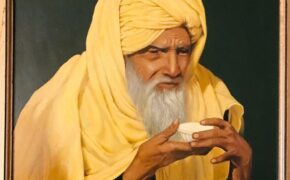Upon rewatching some Crusader films of late, I couldn’t help but be struck by the marked similarity between the revered and mythologised medieval warrior monk knights and the modern plight of the men who have devoted their lives to the liberation of Palestine.
Do you love this picture? Me too! It is called On the Road to Jerusalem and is available to view here.
The Qassam Brigades: Warrior Monks for the New Crusade?
The current siege on the Holy Land by Israel and its western allies has drawn comparisons to a new crusade, echoing historical parallels of religiously motivated conflict and territorial domination. Just as the Crusades of the medieval era were characterized by Western Christian powers seeking to assert control over Jerusalem and the Levant region, the contemporary situation sees Israel and its allies exerting influence and control over the land considered sacred by Jews, Christians, and Muslims alike.
This modern “crusade” is not waged solely through military conquest but also through political manoeuvring, economic pressure, and cultural dominance. Israel’s expansionist policies, supported by powerful Western nations, have led to the displacement of indigenous populations, the annexation of Palestinian territories, and the imposition of restrictions on movement and resources. This echoes the historical Crusaders’ efforts to establish and maintain Christian control over the Holy Land at the expense of local populations a thousand years ago.
Warrior Monks for the New Age
Throughout history, religious fervour has often been a driving force behind military endeavours. That phenomenon seems not to have changed significantly since the initial crusade took place in 1096–1099 AD. This work aims to compare and contrast the modern group known as the Qassam Brigades with the historical counterparts of defenders of the Holy Land during the Crusades, namely the Knights Templar and the Knights Hospitaller.
While these groups of warrior monks are separated by centuries, the groups share striking similarities in a variety of areas, such as their religious devotion, their commitment to defending the Holy Land, and their adherence to codes of chivalry.
Similarities in Religious Zeal
The Qassam Brigades, like the Knights Templar and the Knights Hospitaller, are deeply rooted in religious ideology. Similarly to its historic predecessors, the group is comprised of devoutly religious men. In the case of the Qassam Brigades, these men are Muslims and not Christians; however, the Brigades are identical to the medieval Knights in that they view their struggle as a sacred duty ordained by God.
In even more similarity, the Knights Templar and the Knights Hospitaller were Christian orders formed with the purpose of protecting pilgrims and preserving Christian control over Jerusalem. In this regard, we can see that the Qassam Brigades are motivated by similar incentives. Their goals include the protection of the people, or Palestine, and the restoration of the indigenous lands of their forefathers, currently under occupation by a colonizing power known as Israel. Both groups of men identified with the selfless action of risking their lives in order to protect civilian lives and to allow them to access the sites held sacred to them as believers in the faith and to attend them as pilgrims.
Both sets of warriors saw themselves as instruments of divine will, fighting in the name of their respective faiths but for a common God.
Defenders of the Holy Land
The Qassam Brigades, operating in Gaza, qualify themselves as defenders of the Holy Land against external occupation and aggression. In this regard, their struggle mirrors that of the Knights Templar and the Knights Hospitaller, who fought tirelessly to reclaim and maintain Christian dominion over Jerusalem during the Crusades.
Despite the temporal and geographical differences, the underlying motivation of protecting sacred territory unites these groups. For the Qassam Brigades, their ideology is deeply rooted in the Palestinian struggle for self-determination and the defence of Palestinian territories, including what they consider to be the Holy Land.
From their perspective, they see their armed resistance against occupation and aggression from Israel as a sacred duty ordained by God. The Qassam Brigades often frame their actions within the context of protecting Palestinian land and sovereignty, which they view as part of the broader struggle for justice and liberation.
In this sense, their perception aligns with the idea of defending the Holy Land, albeit from a different perspective compared to other groups or historical contexts.

Noble Code of Conduct
Chivalry and nobility characterize the conduct of the Qassam Brigades, echoing the ethos of the medieval warrior monks. Despite engaging in asymmetric warfare, the Brigades emphasize principles of honour, valour, and self-sacrifice.
The military wing of Hamas operates under a strict code of conduct that emphasizes discipline, loyalty, and adherence to their ideological principles. While specific details of their code of conduct may not be publicly disclosed, we do know that certain principles and norms guide their behaviour both on and off the battlefield.
Here are some key aspects of their code of conduct:
- Discipline and Obedience: Members of the Qassam Brigades are expected to adhere to orders from their commanders and follow a strict chain of command. Discipline is essential for maintaining operational effectiveness and cohesion within the organization.
- Secrecy and Security: Maintaining operational security is paramount for the Qassam Brigades. Members are required to maintain secrecy about their activities and avoid divulging sensitive information to outsiders or rival factions.
- Commitment to Jihad: The Qassam Brigades view armed resistance against perceived occupation and oppression as a religious obligation, or jihad. Members are expected to demonstrate unwavering commitment to the cause and be prepared to sacrifice for the greater good of the Palestinian people.
- Protection of Civilians: Despite engaging in armed conflict, the Qassam Brigades claim to prioritize the protection of civilian lives. They condemn deliberate targeting of non-combatants and assert that their actions are directed towards military objectives.
- Solidarity and Brotherhood: The Qassam Brigades foster a sense of solidarity and brotherhood among their members. Loyalty to the organization and its leadership is emphasized, with a strong emphasis on mutual support and camaraderie.
- Resilience and Perseverance: In the face of adversity and challenges, members of the Qassam Brigades are expected to demonstrate resilience and perseverance. They are encouraged to remain steadfast in their commitment to the Palestinian cause, regardless of setbacks or hardships.
Overall, the code of conduct of the Qassam Brigades reflects their ideological commitment to armed resistance, discipline, and loyalty to the organization and its objectives. It serves as a guiding framework for their activities and behaviour within the context of the Israeli-Palestinian conflict.
This code bears a blatant similarity to the code of conduct of medieval knights. The Knights Templar and the Knights Hospitaller adhered to strict codes of chivalry, which governed their behaviour on and off the battlefield.
This medieval code is believed to be the following:
- Fearlessness: Be without fear in the face of your enemies.
- Bravery in the name of God: Stand brave and upright so that the Lord may love you.
- Honesty: Speak the truth always, even if it means your death, and
- Do Good: Protect the helpless and do no wrong.
Acts of bravery, mercy towards adversaries, and adherence to moral virtues were central tenets for both the modern Qassam Brigades and their medieval counterparts.
Divergence in Methods
While the Qassam Brigades draw inspiration from the historical warrior monks, there are notable differences in their methods and context. Unlike the Knights Templar and the Knights Hospitaller, who operated within the framework of organized states and formal warfare, the Qassam Brigades are attributed a status as a ‘non-state actor’ in a highly contested and complex geopolitical landscape.
Due to their numbers, their tactics often involve guerrilla warfare and asymmetric attacks, necessitated by their disadvantaged position vis-à-vis the modern nation-state of Israel and it’s supporters.
Ancient Values in Modern Warfare
The Qassam Brigades exhibit striking parallels with the warrior monks of the Crusades, particularly the Knights Templar and the Knights Hospitaller. Both groups are driven by religious zeal, dedicated to defending the Holy Land, and guided by strict codes of chivalry.
However, differences in context and methods reflect the evolution of warfare and the changing dynamics of conflict in the modern era. Despite these distinctions, the legacy of the warrior monk endures, embodied in the ethos of the Qassam Brigades as contemporary defenders of the Holy Land.

FOR MORE FANTASTIC FINDS, MAKE SURE TO VISIT MY STORE BELOW
Amazon has graciously invited me to take part in their Amazon Influencer Program. As such, I now have a storefront on Amazon. Don’t forget to check it out to see all my favourite products, such as my bookshelf, my summer and winter fashion finds, and my go-to holistic health products. Please note that some of my posts may contain affiliate links. If you click on an affiliate link and later make a purchase, I may receive a small commission. Clicking on an affiliate link may earn a commission but does not result in additional charges to you or cost you anything extra. However, it helps to support me to keep bringing you honest work.




This Post Has 4 Comments
Your blog has helped me become a more positive and mindful person I am grateful for the transformative effect your words have had on me
I love how this blog celebrates diversity and inclusivity It’s a reminder that we are all unique and should embrace our differences
I truly admired the work you’ve put in here. The design is refined, your authored material stylish, however, you seem to have acquired some trepidation about what you intend to present next. Undoubtedly, I’ll revisit more regularly, similar to I have nearly all the time, in the event you sustain this rise.
I’ve been visiting this site for years, and it never fails to impress me with its fresh perspectives and wealth of knowledge. The attention to detail and commitment to quality is evident. This is a true asset for anyone seeking to learn and grow.